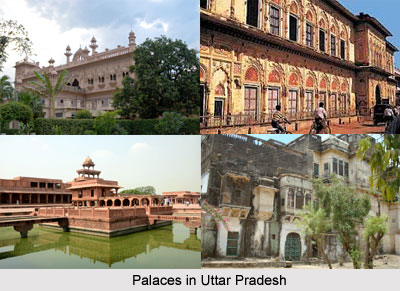 Palaces of Uttar Pradesh give the splendour in arts and architecture of medieval era. These palaces have the designs of Mughal style. Uttar Pradesh has a very vibrant and glorious history from ancient era to the British rule in India. It has been ruled by numerous dynasties in the course of history. Some of the palaces of Uttar Pradesh are Mustafa Castle, Panch Mahal, Senapati Mahal, Bansi Palace and Ramgarh fort and Palaces. Other than these, Agra Fort and Palace and Sikri Fort allure tourists in modern era.
Palaces of Uttar Pradesh give the splendour in arts and architecture of medieval era. These palaces have the designs of Mughal style. Uttar Pradesh has a very vibrant and glorious history from ancient era to the British rule in India. It has been ruled by numerous dynasties in the course of history. Some of the palaces of Uttar Pradesh are Mustafa Castle, Panch Mahal, Senapati Mahal, Bansi Palace and Ramgarh fort and Palaces. Other than these, Agra Fort and Palace and Sikri Fort allure tourists in modern era.
Mustafa Castle
Mustafa Castle is a palace of historical relevance located in Meerut. It was built by Nawab Mohammad Ishak Khan to serve as a memorial to Nawab Mustafa Khan Shefta, his father, who was one of the most eminent and accomplished poets and critics of his era. Mustafa Castle commenced in 1896 to 1897 and the building was completed in 1900.
Panch Mahal
Panch Mahal is a five-story palace in Fatehpur Sikri, Uttar Pradesh. Panch Mahal also known as "Badgir" meaning wind catcher tower was commissioned by Sikarwar Rajputs. This structure stands close to the Zenana quarters (Harem) which supports the supposition that it used for entertainment and relaxation.
Rani Mahal
Rani Mahal is a royal palace belonged to the queens of Jhansi in the city of Jhansi, Uttar Pradesh. The palace was built by Raghu Nath-II of the Newalkar family (1769-96). This palace later formed one of the residences for Rani Lakshmibai.
Senapati Mahal
Senapati Mahal is a palace built by Senapati, son of Jagat Rai and grandson of Chhatrasal in the year 1700 in Kulpahar on a hillock. The palace is now a protected monument under the preservation of Archaeological Survey of India.
Bansi Palace
Bansi Palace is located on the banks of the river Rapti in Siddharthnagar District, Uttar Pradesh. Bansi Palace is merely 30 Kilometers from Piparhwa (Kapilavastu). It is one of the significant historical buildings in the district. It received its popularity when "Stupa" was discovered in the year 1897. The beautiful district is named after Prince Siddhartha, which was the name of Lord Buddha till he achieved his wisdom before the age of 29 years. It is believed that he spent his early years in Kapilavastu which is located within this very district.
Ramgarh Palace
Ramgarh Palace in Varanasi was a place and the fort of medieval era. It has a museum which is worth visiting. The fort is known as Ramgarh Fort and is on the leeward side of the Ganga ghats in Varanasi. The fort is very small in comparison to the one in Agra and Fatehpur Sikri but is very aesthetically designed. The fort of Rani of Jhansi in the city of Jhansi and the one belonging to Tantia Tope and Nana Saheb in the adjoining town of Bithoor are worth visiting too.



















